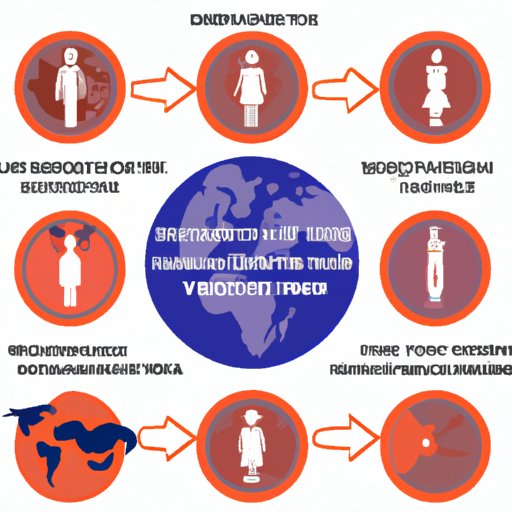
I. Introduction
Vector borne diseases are transmitted by vectors like mosquitoes, ticks, fleas, and sandflies. These diseases can have a significant impact on human health, and in some cases, can even be fatal. In this article, we will explore what vector borne diseases are, how they are transmitted, and what measures can be taken to prevent them.
II. Understanding Vector Borne Diseases: What You Need to Know
Vector borne diseases are illnesses caused by microorganisms like bacteria, viruses, and parasites. These microorganisms are transmitted to humans through the bites of infected vectors like mosquitoes, ticks, fleas, and sandflies. Some common vector borne diseases include malaria, dengue fever, Lyme disease, and Zika virus.
The type of vector that transmits a disease depends on the specific disease. For example, mosquitoes are the primary vectors for malaria and dengue fever, while ticks are the primary vectors for Lyme disease and tick-borne encephalitis. Fleas can transmit diseases like plague, while sandflies transmit leishmaniasis.
III. From Mosquitoes to Ticks: How Vector Borne Diseases are Spread
Vector borne diseases are spread when an infected vector bites a human host. During the bite, the microorganism responsible for the disease is passed from the vector to the human host. The microorganism then multiplies in the human host, causing illness.
The transmission cycle of a vector borne disease typically involves four stages: the pathogen, the vector, the host, and the environment. The pathogen is the microorganism that causes the disease. The vector is the organism that transmits the pathogen to a human host. The host is the human who serves as a reservoir for the pathogen. The environment includes factors like temperature, humidity, and vegetation, which affect the survival and distribution of the vector and the pathogen.
Preventing transmission of vector borne diseases involves interrupting the transmission cycle. This can be done by controlling the vector through measures like mosquito nets, insecticides, and eliminating breeding sites. Additionally, vaccines and medications can help prevent infection and manage symptoms.
IV. The Science Behind Vector Borne Diseases and Their Prevention
Scientific research plays a crucial role in understanding vector borne diseases and developing effective prevention methods. Current prevention methods include insecticide-treated bed nets, insecticide sprays, and vaccinations. While these interventions have proven effective, there is still a need for new prevention measures, especially in areas where mosquitoes have developed resistance to insecticides.
Emerging prevention methods include new vaccines, gene editing of mosquitoes, and novel strategies for vector control. Gene editing involves altering the DNA of mosquitoes to reduce their ability to transmit diseases. Novel strategies for vector control include using bacteria that inhibit the ability of mosquitoes to transmit diseases.
V. A Complete Guide to Vector Borne Diseases and Their Symptoms
There are several common vector borne diseases, each with its own set of symptoms and treatments. Malaria, for example, can cause fever, chills, and headache. Dengue fever can cause severe joint and muscle pain, along with a high fever. Lyme disease can cause a distinctive rash and flu-like symptoms.
Diagnosis of vector borne diseases typically involves a combination of clinical assessment, laboratory testing, and medical history. Treatment varies depending on the disease and may include antibiotics, antiviral medication, and supportive care like fluids and pain relief.

VI. The Global Impact of Vector Borne Diseases: Challenges and Solutions
Vector borne diseases have a significant impact on global health, particularly in low and middle-income countries. Several factors contribute to the spread of vector borne diseases, including poor sanitation, inadequate housing, and limited access to healthcare.
Controlling the spread of vector borne diseases requires a multi-faceted approach. This includes improving sanitation and housing conditions, increasing access to healthcare, and implementing effective vector control measures like insecticide spraying and mosquito nets. Additionally, increased funding for research and development of new prevention measures is crucial for making progress against vector borne diseases.
VII. Vector Borne Diseases in Developing Countries: Causes and Consequences
Vector borne diseases have a particularly devastating impact on developing countries. Factors like poverty, lack of access to healthcare, and poor infrastructure can exacerbate the spread of these diseases and make them harder to control.
Consequences of outbreaks in low-income areas include increased mortality and morbidity rates, decreased productivity, and reduced economic growth. Addressing these challenges requires a concerted effort from policymakers, healthcare professionals, and community leaders.
VIII. Vector Borne Diseases and Climate Change: How Environmental Factors Affect Transmission
Climate change is having a significant impact on the spread of vector borne diseases. Changes in temperature, rainfall, and humidity can alter the distribution and behavior of vectors like mosquitoes, ticks, and fleas.
Strategies for mitigating the impact of climate change on vector borne diseases include improving surveillance systems, developing new vector control methods, and increasing public awareness. Additionally, measures like reforestation and reducing greenhouse gas emissions can help address the underlying environmental factors contributing to the spread of vector borne diseases.
IX. Conclusion
Vector borne diseases pose a significant threat to human health, particularly in developing countries. However, with increased awareness, research, and funding, progress can be made in controlling the spread of these diseases. Key strategies for prevention and management include vector control measures, improving healthcare access, and addressing environmental factors like climate change.




